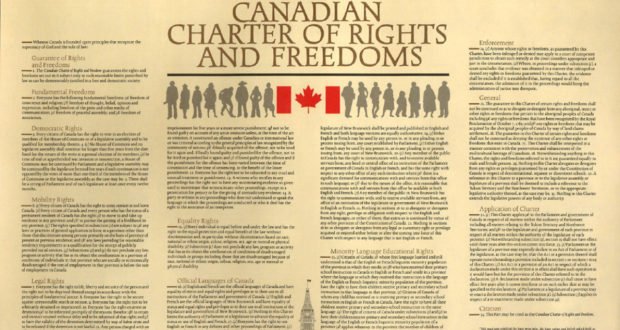Professor Kerri Froc has written a thoughtful guest post for Double Aspect, in which she argues that s. 28 of the Charter is not merely an interpretive provision, but is rather a substantive and justiciable section in its own right. The implication if she is correct should not be understated.
Section 28 states: Notwithstanding anything in this Charter, the rights and freedoms referred to in it are guaranteed equally to male and female persons. Professor Froc argues that the addition of the non obstante (notwithstanding) clause in s. 28 means that s. 28 is paramount to all other sections in the Charter. She specifically cites s. 33, but the necessary implication of her position is that s. 28 would also supersede, and therefore not be subject to, s. 1. A government could not invoke the notwithstanding clause in the face of a sexually discriminatory law, nor could it argue that the law imposed a “reasonable limit.” Sexual equality, in other words, would hold the unique status of being an absolute right.
In this post, I will tackle Professor Froc’s interpretation of s. 28. I will first argue that while s. 28 is an important interpretive provision, it does not contain an independent and justiciable right. It is certainly plausible to read s. 28 as not being subject to s. 1’s reasonable limits; however, a Charter right guaranteed to one sex but not the other would arguably never constitute a reasonable limit regardless. Following from this, I will argue that, since s. 28 does not contain an independent and justiciable right, and since Charter provisions should be read harmoniously whenever possible, s. 28 does not negate the application of s. 33 to laws that discriminate on the basis of sex. Section 28 concerns the proper interpretation of rights, while s. 33 concerns the operation of laws that violate those rights. Both provisions are therefore capable of coexisting without recourse to s. 28’s non obstante clause.
The Text and Context of Section 28
Professor Froc is a well-recognized authority on the history of s. 28 of the Charter. Her work has admittedly piqued my interest and I have since taken the liberty of reading many of the Charter debates, which can now be accessed on PrimaryDocuments.ca – MP Scott Reid’s outstanding public service achievement. There can be no dispute that many women’s groups fought hard for the inclusion of this section. The fact that it was not only included, but was amended to read “Notwithstanding anything in this Charter” must mean something more than nothing. But it does not follow that simply because the provision has meaning, it must therefore contain an independent and justiciable right.
The history of s. 28’s enactment is certainly interesting in its own right, but great care should be taken in how we utilize that history. Statements made by legislators or interest groups do not form binding interpretations of law. As Lord Sankey said in the famous Persons case, “the question is not what may be supposed to have been intended, but what has been said.” The desire of certain lobbyists and legislators to enumerate a blanket right of “sexual equality” cannot supersede the legal meaning of the provision that was ultimately enacted.
Professor Froc is correct that s. 28 begins with the words “Notwithstanding anything in this Charter.” On its face, this means that s. 28 supersedes all other provisions of the Charter to the extent there is any conflict, including s. 1. However, it is a well-established principle of statutory interpretation that non obstante clauses do not create conflicts; they merely state which provision prevails in the event of a conflict (see Antonin Scalia & Bryan A. Garner, Reading Law: The Interpretation of Legal Texts (St. Paul, MN: Thomson/West, 2012) at 126 – 128). Thus, it would be premature to conclude the matter simply by noting the presence of the non obstante clause at the outset of s. 28. The question remains: what exactly is it that supersedes the rest of the Charter in the event of a conflict?
Section 28 plainly does not enumerate a separate right. It refers to the rights already enumerated in the Charter and states that those rights are “guaranteed” equally to men and women. The wording of s. 28 mirrors that of s. 1. Both speak of the rights and freedoms set out in the Charter as being “guaranteed” (the French words are also the same – garantit/garantis) and it is reasonable to conclude that the words have the same meaning in each section. Section 1 clearly conveys something akin to a promise or an assurance of possession. Section 28 is therefore properly interpreted to mean that this assured possession rights applies equally to men and women.
The non obstante clause in s. 28 means that a failure to guarantee a right or freedom equally to men and women can never be justified as a reasonable limit under s. 1. But even in the absence of s. 28, it is difficult to conceive of how an unequal possession of Charter rights could ever be justified as a reasonable limit. Professor Leonid Sirota has argued in a recent post that some rights infringements, by their very nature, are never acceptable in a free and democratic society. Guaranteeing fundamental rights and freedoms to some citizens but not others would seem to be a prime example. If the state limits the ability only of women to express opinions or only of men to associate, or imposes greater burdens upon one sex in relation to the exercise of a right or freedom, it seems implausible that this state action could ever have a pressing and substantial concern, let alone be proportionate. Presumably, whatever pressing and substantial objective warranted the limiting of one sex’s rights or freedoms would ipso facto apply to the other sex as well. The unequal limitation of rights is therefore prima facie proof that the limitation is unreasonable.
In the context of s. 15 of the Charter, s. 28 ensures that the rights set out therein are guaranteed equally to men and women. But s. 15 does not provide a blanket right to “sexual equality.” It enumerates the right of equality before the law and under the law and the right to equal protection of the law and equal benefit of the law without discrimination. In what I hope will be a subsequent post, I will discuss what I consider to be the proper interpretation of s. 15. Suffice it to say at this stage that an infringement of s. 15 requires the state to discriminate, meaning to draw not only a distinction, but one that is fundamentally irrational or arbitrary. And while that discrimination need not be present on the face of the law, it must necessarily flow from the law’s operation – what I call substantive legal equality, to be contrasted with substantive factual equality. Thus, whereas “sexual equality” could be interpreted to mean equality of outcome between the sexes, the right to “equal benefit of the law without discrimination based on sex” is right to be free from laws that, either on their face or necessarily by virtue of their operation, draw arbitrary distinctions between the sexes. Section 28 ensures that an infringement of this right will not be saved by s. 1, but, once again, this is unlikely in any event. How could a law that draws unreasonable distinctions ever be justified as a reasonable limit?
The statutory context further supports the argument that s. 28 is a valuable interpretive aid, but not a standalone rights guarantee. The provision that became s. 28 was not included in the “Equality Rights” part of the Charter; it was placed in the part of the Charter entitled “General.” This is instructive. The six other sections in this part of the Charter clearly deal either expressly or implicitly with how the Charter is to be interpreted. Section 25 says the Charter shall not be interpreted to derogate from aboriginal or treaty rights. Section 26 says the enumeration of certain rights in the Charter shall not be construed as denying the existence of other rights. Section 27 says that Charter shall be interpreted in accordance with Canada’s multicultural heritage. Section 29 says that the Charter shall not be interpreted to deny the rights and privileges guaranteed elsewhere in the Constitution in respect of separate or denominational schools. Section 30 says that a reference to a province or legislative assembly shall include the Yukon Territory and Northwest Territories. And section 31 says that the Charter shall not be interpreted to extend legislative authority. It seems unlikely, to say the least, that the most far-reaching and absolute right enumerated in the Charter would be placed smack dab in the middle of the part dealing with interpretation.
In his paper entitled “In the Beginning …: The Origins of Section 15 of the Charter,” the Honourable B.L. Strayer, a former justice of the Federal Court and Chief Justice of the Court Martial Appeal Court, recounts his involvement with the drafting of the Charter. He states that s. 25 (aboriginal and treaty rights) and s. 27 (multiculturalism) were added because some aboriginal groups and minorities did not want equality guarantees to limit their traditional practices. According to Strayer, this caused concern to feminist groups who wanted to ensure that the protections afforded to aboriginal groups and minorities were not prejudicial to women. It was for this reason that s. 28 was added.
To be sure, the intent or understanding of any one or more of the framers is of limited relevance. But Strayer’s recounting of the drafting process certainly dovetails with the structure of the Charter. The General part of the Charter follows the enumeration of rights and each of its provisions serve as clarification for the preceding substantive rights provisions. Sections 25 & 27 qualify the rights set out in s. 15, and s. 28 further clarifies that ss. 25 & 27 cannot be used to undo the Charter’s basic guarantee of equal rights to men and women. That guarantee exists “notwithstanding anything in this Charter,” but as a practical matter it makes sense that the provision was targeting ss. 25 & 27. Section 28 is flanked by various interpretive provisions for the simple reason that it is one as well.
Notwithstanding the Notwithstanding Clause
As noted above, Professor Froc argues that s. 28, by virtue of its non obstante clause, trumps s. 33, which states that Parliament or a provincial legislature may declare that a statutory provision operates “notwithstanding a provision included in section 2 or sections 7 to 15 of this Charter.” In Professor Froc’s view, s. 33 cannot be used to “override” a law that sexually discriminates or that disproportionately violates the rights of men and women. Section 28’s notwithstanding clause, in other words, operates notwithstanding the notwithstanding clause in s. 33.
Professor Froc’s position relies on both the text and history of s. 28. With respect to the former, she notes that s. 28’s non obstante clause applies to the entire Charter, whereas s. 33’s only applies to ss. 2 & 7 – 15. With respect to the latter, she points to earlier drafts of s. 28, which had expressly exempted s. 33 from its application. The removal of this exemption in the final draft must mean something, and the most plausible meaning is that the framers did not want s. 33 to override violations of s. 28. I will address each of these arguments in turn.
The textual argument seems straightforward enough at first glance. There can be no doubt that, to the extent of any conflict between the two provisions, s. 33 would yield to s. 28’s broader non obstante clause. That’s true so far as it goes. However, as discussed, the presence of a non obstante clause merely dictates which provisions prevails in the event of a conflict; it does not signify the existence of one. And, in the absence of a clear conflict, it is another well-established principle that statutory and constitutional provisions be read harmoniously wherever possible.
As discussed, s. 28 deals with the rights Canadians possess and particularly how to interpret those rights. Section 33, by contrast, deals with the operation of legislation that is contrary to those rights. There is nothing inherently inconsistent with Canadians possessing rights and the government possessing the authority to enact legislation notwithstanding those rights. As Professor Grégoire Webber recently argued in a piece for Policy Options, the invocation of the notwithstanding clause does not act as a bar to judicial review since the issue of whether a right has been violated is separate and distinct from whether government legislation may continue to operate in spite of the violation. Section 28 ensures that Charter rights are possessed equally by both men and women, but it says nothing about the operation of legislation that violates those rights. If a provincial legislature passes a law that prevents women from wearing any religious symbols in public, that law would violate s. 2(a) and could not be saved by s. 1. However, if the government invoked s. 33, the law would continue to operate notwithstanding the clear violation of s. 2(a).
Implicit in Professor Froc’s position seems to be the contention that the word “guaranteed” in s. 28 actually means something more than just an assurance of possession – perhaps something akin to a promise against actual real life infringement by the state. If s. 28 stated that the equal rights of men and women could never be infringed by the state, then naturally this would conflict with s. 33, and s. 28’s non obstante clause would prevail. However, the textual clues indicate that the word “guaranteed” is not meant to be read this broadly. As noted above, s. 1 uses the same verb and it clearly has a narrower meaning in that section along the lines of an assurance of possession. If s. 1 said that the state could never infringe rights (whose meanings were subject to reasonable limits), then it too would come into direct conflict with s. 33, which expressly empowers the state to do just that. Sections 1 and 33 are textually compatible for the very reason that they speak to different things: possession and operation. So too with ss. 28 & 33.
This broader interpretation of “guaranteed” would also render the supremacy clause in s. 52 superfluous. The supremacy clause states that any law that violates the Charter is of no force or effect. As Professor Webber argues, s. 33 serves as an exception to s. 52. But the corollary is that without s. 52, you would not need s. 33. The courts could find various rights violations, but those violations would not affect the operation of the unconstitutional legislation. Section 52 transforms what would otherwise be little more than moral affirmations into a practical enforcement of rights. However, if s. 1 (and s. 28) of the Charter provided an assurance that rights would never be infringed, then s. 52 would no longer be necessary (or at least the “of no force or effect” clause). The rights themselves would hold practical weight. The inclusion of s. 52 is as good a textual indicator as one will find that “guarantee” in ss. 1 and 28 speak to the possession of rights not their enforcement or application.
What, then, of the history of s. 28? This is perhaps the most persuasive part of Professor Froc’s argument. There is no dispute that s. 28 was amended to remove the phrase “except section 33,” and this certainly suggests that the framers wanted to ensure that s. 28’s equality guarantee was not ousted by s. 33. Once again, however, we must tread carefully when entering the labyrinth of legislative intent. The fact that those who advocated for the amendment of s. 28 may have sought to keep it insulated from s. 33 tells us very little about the legal meaning of those provisions, especially but not only since many of these advocates were not legislators and did not vote on the final product.
Similarly, while changes to drafts of legislation are certainly relevant, they are far from determinative. As Professor Froc notes, the s. 33 exception was inserted into s. 28 following the Kitchen Accords. Those concerned about retaining legislative autonomy, and particularly provincial legislative autonomy, were likely worried about the potential far-reaching effect of s. 28 and pushed for the s. 33 exception on this basis. But it does not follow that they had a proper legal basis to be concerned or that the inclusion of s. 33 exception accomplished anything new. Conversely, those who advocated the removal of the s. 33 exception may have truly believed that they were preventing s. 33 from being invoked in the face of a sexually discriminatory law. But this does not mean that they were correct as a matter of proper textual interpretation. As with many amendments that invariably occur during a bill’s drafting process, the amendments to s. 28 undoubtedly mattered a great deal to their sponsors, but their effect on the ultimate interpretation of the law was negligible.
Conclusion
Professor Kerri Froc has done some very important work unearthing the history of s. 28 and bringing new light upon a provision of the Charter that has been all but ignored by the courts. My conclusion that s. 28 is properly understood as an interpretive provision should not be misconstrued to mean it is unimportant. On the contrary, s. 28 tells us much about the nature and scope of Charter rights and underscores that certain limitations upon rights can never be reasonable in a free and democratic society. Section 28 serves a valuable purpose, but it does not contain an independently justiciable right, nor does it oust the application of s. 33 where rights have been infringed in a sexually discriminatory manner. This may not be what some of our Charter’s framers intended, but it is ultimately what they said.
 Advocates for the Rule of Law
Advocates for the Rule of Law



